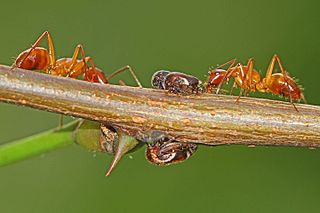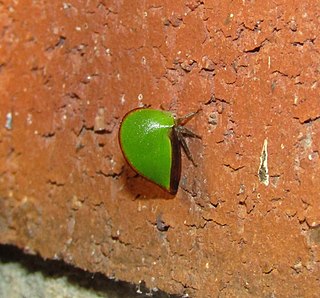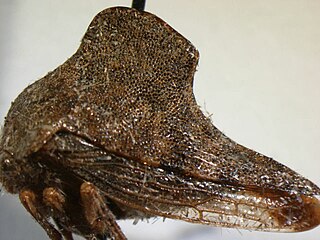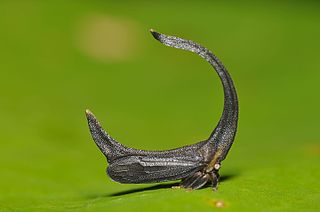
The prothorax is the foremost of the three segments in the thorax of an insect, and bears the first pair of legs. Its principal sclerites are the pronotum (dorsal), the prosternum (ventral), and the propleuron (lateral) on each side. The prothorax never bears wings in extant insects, though some fossil groups possessed wing-like projections. All adult insects possess legs on the prothorax, though in a few groups the forelegs are greatly reduced. In many groups of insects, the pronotum is reduced in size, but in a few it is hypertrophied, such as in all beetles (Coleoptera). In most treehoppers, the pronotum is expanded into often fantastic shapes that enhance their camouflage or mimicry. Similarly, in the Tetrigidae, the pronotum is extended backward to cover the flight wings, supplanting the function of the tegmina.

Treehoppers and thorn bugs are members of the family Membracidae, a group of insects related to the cicadas and the leafhoppers. About 3,200 species of treehoppers in over 400 genera are known. They are found on all continents except Antarctica; only five species are known from Europe. Individual treehoppers usually live for only a few months.

The Auchenorrhyncha suborder of the Hemiptera contains most of the familiar members of what was called the "Homoptera" – groups such as cicadas, leafhoppers, treehoppers, planthoppers, and spittlebugs. The aphids and scale insects are the other well-known "Homoptera", and they are in the suborder Sternorrhyncha.

The buffalo treehopper is a species of treehopper belonging to the subfamily Smiliinae. It is sometimes classified as Ceresa bisonia.

Stictocephala is a genus of treehoppers in the family Membracidae; in the subfamily Smiliinae and tribe Ceresini. Species appear to be distributed mostly in North America, but S. bisonia has become widely distributed in Europe.

Centrotus cornutus (thorn-hopper) is a species of "treehoppers" belonging to the family Membracidae.

Enchenopa binotata is a complex of multiple species found mostly in Eastern North America, but have also been reported in Central America. They are commonly referred to as treehoppers and are sap-feeding insects. The species in the complex look similar to each other in morphology, but are identified as different species by the host plant they occupy.

Aetalionidae are a family of treehoppers in the superfamily Membracoidea. Aetalionidae are somewhat like Membracidae in that they have one to three rows of short spines on the hind tibia but differ in having the front femur fused to the trochanter and the scutellum is completely exposed. The females have finger-like protrusions on the genital capsule. The family is mostly Neotropical. The subfamily Biturritiinae is Neotropical while the subfamily Aetalioninae has a Neotropical genus Aetalion and the sole Old World representative genus Darthula with a single species Darthula hardwickii.

Entylia carinata, commonly known as the keeled treehopper, is a species of treehopper in the family Membracidae. They can be found in Brazil, Panama, Mexico, the United States, and Canada. Keeled treehoppers are often attended by ants which feed on the honeydew they excrete. In return, the ants offer protection from predators. Keeled treehoppers typically feed on plants in the aster family and they are not known to transmit plant diseases and are not considered significant plant pests.

Smiliinae is a subfamily of treehoppers in the family Membracidae. These are bugs and include about 100 genera in 10 tribes.

Thelia is a genus of treehoppers in the family Membracidae. There are at least two described species in Thelia.

Vanduzea is a genus of treehoppers in the family Membracidae. There are about 12 described species in Vanduzea. The genus was named after American entomologist Edward Payson Van Duzee.

The Brazilian treehopper is a species of insect belonging to the treehopper family (Membracidae). It has unusual appendages on its thorax. While Bocydium can be found throughout the world, they are most prevalent in Africa, North and South America, Asia and Australia. They exhibit limited movement and their primary food source is from the underside of leaves. They also exhibit hemimetabolous development. Treehoppers range from about two millimeters to two centimeters in length.

Archasia is a genus of treehoppers in the family Membracidae.

Stictocephala alta is a species of treehopper in the family Membracidae.

Telamona agrandata is a species of treehopper in the genus Telamona.
Archasia pallida is a species of treehopper in the family Membracidae.
Archasia auriculata is a species of treehopper in the family Membracidae.

Cladonota is a genus of treehopper in the family Membracidae, widespread through North and South America. It has been previously described as Spogonophorus.

Stictocephala diceros, the two-horned treehopper, is a species of hemipteran insect within the family Membracidae. The species range includes much of eastern North America, which includes southeastern Canada in areas adjacent the United States border and US state regions such as the Midwest, Northeast, Southeast, as well as some western states such as Utah, Colorado, and New Mexico. The species inhabits temperate and hardwood forests, where it primarily feeds on American black elderberry, although its known to feed on other flowering plants such as those in the Asteraceae, Fabaceae, Fagaceae, and Rosaceae families. The species reaches 8 to 9 millimeters in length with a brown coloration.

















